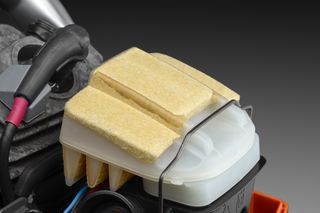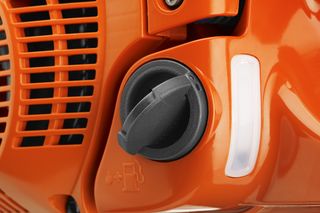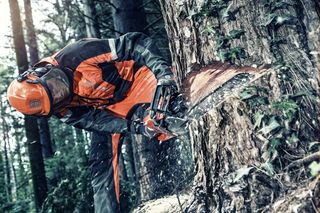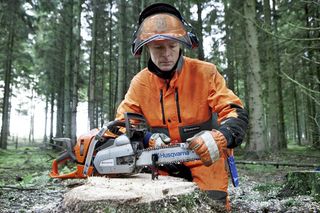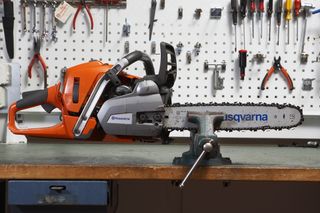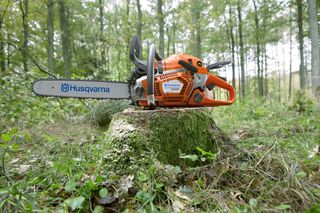Preparing Your Garden for Winter - The Complete Guide
At this time of year, most gardens are on the verge of entering winter dormancy. But just because things are starting to slow down and get ready to enjoy a well-deserved rest, doesn't mean that the same is true for you. Winter can be a brutal time for your grass, plants and soil; so a helping hand is needed if you want it to thrive come spring. With everything falling into a deep slumber, your usual, everyday garden chores such as mowing, trimming, feeding and watering will take a back seat. The great thing about autumn and winter gardening is that you get to reset the clock and guide your landscape in the direction you want. Last year's hot-bed can be next year's veggie patch and overgrown trees can be brought down to size. Here are some things you can do to prepare your garden for winter and make the most of the crisp, fresh air.
Gardening in winter - Jobs to do
- Hard and heavy pruning of certain plants
- Getting your soil ready for spring
- Planting out your winter seedlings
- Germinating early season plants
- Deep clean your greenhouse
- Improve the drainage of your lawn
- Maintain and prepare garden tools
- Cut down diseased or dead trees
- Mulch around non-hardy plants
- Get a head start on weed and pest control
- Turn your compost heap
- Take care of cool-season grass
- Restore life back to garden furniture
Plants to prune in winter
Many people choose to prune their plants in winter, and for good reason. Winter pruning drastically reduces the likelihood of disease or infection setting into fresh cuts. Most plants are also in a state of dormancy, meaning their energy is stored in their root systems and not in the stems, branches or leaves, resulting in less shock and a lower risk of dying off.
Some more common plants that benefit from winter pruning include:
- Apple trees
- Deciduous shrubs and trees
- Fig trees
- Grapevines
- Pear trees
- Roses
- Soft-fruit bushes
- Summer clematis
- Wisteria

Hand Pruning Winter Tips
Make sure that your pruning secateurs are nice and sharp. It's always recommended to sterilise them before use and when moving on to the next plant.
Start by removing any damaged, diseased or dead wood. This is the same for all plant varieties.
For top growth, make a cut directly above outward-facing buds nearest to the main stem or trunk.
Always try to get as close to the bud as you can to help prevent die-back.
When making cuts, do them at a 90° angle to allow water to run off and the wound to dry.
Don't be afraid to go hard on your pruning. It's surprising just how resilient most plants are.
Trimmer Pruning Winter Tips
Use a hedge trimmer with a shorter knife length. This helps prevent accidental damage to the main stem or trunk.
Make sure you sterilise the cutting knife properly before you get started.
Work little by little and work your way inwards, leaving at least 3 buds on each branch closest to the main stem.
Ideal for taking care of vines, climbers and shrubs that have grown out of shape.
Not great for use on roses or other susceptible plants as the cuts aren't angled nor as clean as hand secateurs.
Winter soil prep
Winter is the perfect time to check your soil PH levels as plants go into hibernation. The optimal number is a PH of 6.5 and a quick home test can help you with this. Knowing what the PH levels make it much easier to adjust them with a liming material.
Another thing every gardener should know is what materials their soil is made up of. Knowing your soil type can make it easier to choose plants that will thrive in its composition, resulting in maximum growth and blooming.
Here's how to check your soil at home.
- Use a hand trowel and remove a little bit of soil from 6 different parts of your garden.
- Put it in a clear jar filled with clean water and then tighten the lid nice and securely.
- Give the jar a good shake for 30 seconds, mixing and swirling the contents properly.
- Leave the contents to settle in the jar for around 10 minutes or until the water turns clear again.
The organic matter will begin to settle by weight, with the heaviest and densest material settling at the bottom. There will be between three and four predominant layers, with a layer floating at the top. Here's how to decipher the contents.
- Floating top layer. Organic leaf matter and debris that helps to retain soil moisture levels.
- Second to top. This layer will be silt. This promotes air circulation and water retention.
- Beneath the silt is the clay layer. Retains moisture and is nutrient-rich. Also makes it easier for roots to anchor.
- The lowest layer will be sand. This helps improve drainage and improve root depth.
Measure the height of each layer with a ruler, then divide this with the total measurement of the three main layers. The ideal percentages are 40% sand, 40% silt, 20% clay. Once you know the organic make-up of your soil, it's much easier to know where to make adjustments for improved health and growth of your plants, trees and shrubs. Using a soil tiller can help improve soil quality by lifting heavy matter to the upper layers and vice versa. It also improves the distribution of organic matter, such as compost, leaf litter and mulch.
Clean your greenhouse
Greenhouses and poly grow tunnels are pretty much used 365 days a year. This makes it hard to keep them in tiptop condition, especially when it comes to the glass or poly sheeting. Everything from pollution to water residue can prevent maximum sunlight reaching your tender plants and seedlings. Winter is the ideal time to give it a deep clean and ready for another year of protected growth.
The easiest way to clean the glass and frame of your greenhouse is with a pressure washer and a few attachments. Here's the best way to get sparkling glass and a rust-free frame:
- Start from the top down to prevent run-off from messing up already cleaned areas. If the top of the greenhouse is too high to reach, an Angled Spray Lance attachment will help.
- As the glass or poly sheeting can be fragile, you'll want to use a low-pressure attachment. Both the Rotating Brush Kit and the Vehicle Cleaning Kit are perfect for this.
- Try to use a mild cleaning solution designed for use on glass. Preferably one with an additional UV protection coating included.
- Pay close attention to seals, frame joints and door and window openings. Go gentle here as you don't want to cause damage to these important parts.
- Dry the frame down when you're finished while leaving the glass or poly-tunnel sheeting to air dry. This will prevent scratches or heavy-handed damage to the delicate parts.
- Give the floor of your greenhouse a good washing down, taking the chance to spot any deterioration that needs to be fixed.
- Lastly, use gentle mineral oil on any hinges or door slides to ensure things don't seize up.

Breathe life into your lawn
Late autumn is the best time to aerate your lawn if you have warm-season grass. Late spring is when to deal with cool-season grass. Aeration provides your lawn with a variety of benefits. From improving airflow to increasing drainage, your lawn will love you for it.
Choosing a time before your grass goes dormant gives your lawn a chance to heal and regrow in any freshly plugged spaces. Applying a gentle fertiliser post-aeration will top up nutrition levels, giving it a head-start come spring.
Most lawns will be small enough to benefit from manual aeration. All you'll need is a garden fork, some sturdy boots and plenty of energy. Dig the fork into the ground, using your feet to drive it as deeply as possible. Work the fork in a backward and forward motion with your hand to create holes around an inch wide. Rinse and repeat the process every 30 cm.
If you have a large area to cover, such as parkland, estate grounds or larger than average lawns; a tow behind aerator can speed up the process tenfold. The depth of ground penetration is determined with the use of weight containers and they can cover an area of up to four acres in a single hour.

Get rid of the deadwood
Dead or decaying branches on trees are not only unsightly, but they can also be dangerous-especially during winter. Storms, cold weather and damp can make them an accident waiting to happen. Winter is the ideal time to get your chainsaw out and bring old trees down to size.
As it's the quietest time of the year for both growth and noise pollution - a battery series chainsaw can help keep noise levels down while offering a lightweight and powerful way to deal with deadwood.
For diseased trees, winter is cool enough to prevent fungal spores and parasites from spreading easily. As most species will be dormant, infection rates will be much lower. If you need to reach high up and don't fancy balancing in a ladder with a chainsaw, a pole saw could be exactly what you're looking for.
Spray hibernating pests away
Mealybugs, grasshoppers, cabbage moths and aphids can all wreak havoc in your garden. With over 4,000 types of aphids out there, the two most common types found in Australian gardens are the cotton and cabbage aphids. Taking care of eggs and young pests now can reduce their numbers come spring.
A garden sprayer can help you quickly and easily get rid of impending pests. You can use a deterrent of your choosing, from wettable pesticides to organic solutions.
Aphids love nitrogen, which is why they're found in an abundance in chemically-fertilised areas. Autumn and winter is the perfect time to spray leaves with a gentle detergent solution - enough to kill the unhatched larvae. Using weedkiller to eliminate weeds is also recommended as this is a favourite overwintering spot of aphids.
Cabbage Moths. The larvae of the Cabbage Moth overwinters in the soil. Turning your soil every year and rotating your plants can help prevent it. In summer and autumn, they lay their eggs on plants, which takes between 4 - 8 days to hatch. A general-purpose insecticide will work well on destroying the eggs.
Mealybugs. This one might come as a surprise, but most mealybugs are brought into the garden by ants - the same is true with aphids. You can disrupt ant trails with dish-washing detergent or a gentle pesticide. If you find any adult mealybugs, rubbing alcohol and water will kill them off nicely. Eggs are robust and can survive freezing and thawing, so a stronger pesticide might be needed.

Take care of garden woodwork
After a whole year of use, garden furniture probably needs a little bit of TLC. Long, hot summers dry the wood out, causing it to shrink and crack. As the cold and wet weather approaches, this can seep into your wooden furniture and cause it to rot from the inside out.
Start by washing down all of your furniture with a pressure washer and a Stone and Wood cleaning solution. Choosing a warm and sunny day in autumn is best for this. Remove any lichen, moss and debris and then leave it to dry for at least 3 days.
When everything is nice and dry, give it a gentle sanding down and then apply a wood stain with waterproofing properties. You have to be certain that the wood is dry before doing this as the last thing that you want to do is trap moisture inside.
This can be done on all wooden fixtures, including fencing, decking, wooden doors, and garden ornaments. If you have a patio, give that a good clean too and then fill in any spaces with sand and a hard-bristled brush.
Know when to mow
As autumn draws to a close, it's time to let your grass grow a little bit longer for winter. Raise the height of your lawn mower cutting deck to between 2 and 2 ½ inches. This helps your grass survive through the colder months by leaving enough of a blade for improved photosynthesis. Two inches is the golden number. It's short enough to prevent the growth of mould and moss, but long enough to keep the roots protected from frost damage.
Lawns made up from Ryegrass, Fescue, Bentgrass or Kentucky Bluegrass will grow through winter, meaning winter mowing is often required. Those with Zoysia, Kikuyu, Buffalo and Couch varieties are warm-season grasses and will need their last proper cut before the cold weather sets in.
If you’re not a fan of mowing or would rather focus on other parts of winter garden care, the Husqvarna Automower® can be set to maintain your lawn for you. This fully programmable robotic mower will run to a set schedule, keeping the grass at the chosen height and can work in all types of weather throughout the year.
If you’re using a manual mower and not quite sure what to do with your grass clippings, you can either throw them on the compost heap or use them as a protective mulch base for tender tropical plants.

Wrapping things up
These winter garden prep chores will keep you busy over the coming months. Enjoy the beauty and tranquility that the season brings while giving your lawn and plants everything they need for a strong start come spring.
Using high-quality and durable garden tools will give you superior results with less time and effort needed. From mowing and growing to feeding and cleaning, Husqvarna has the perfect tools for all of your yard and garden jobs come spring, summer, autumn and winter.


